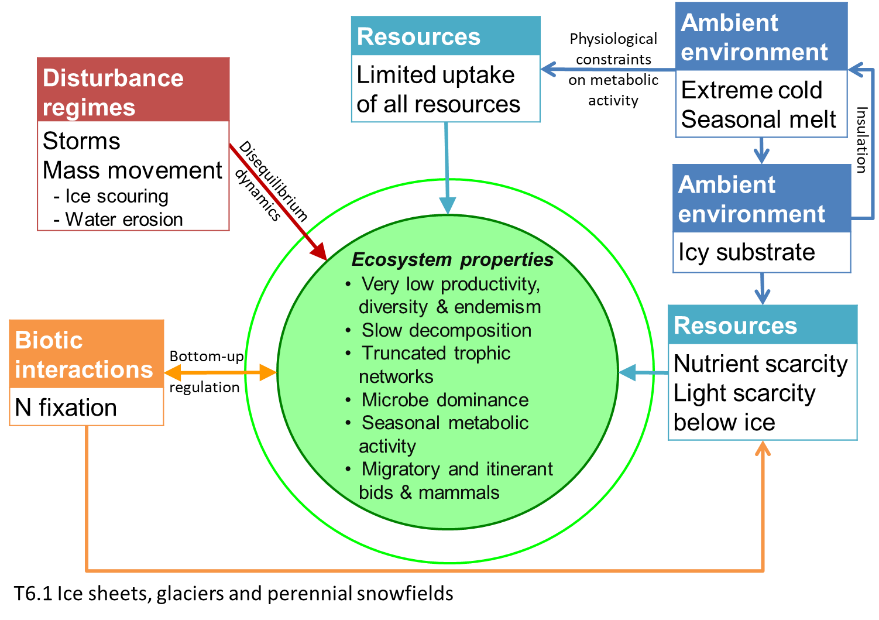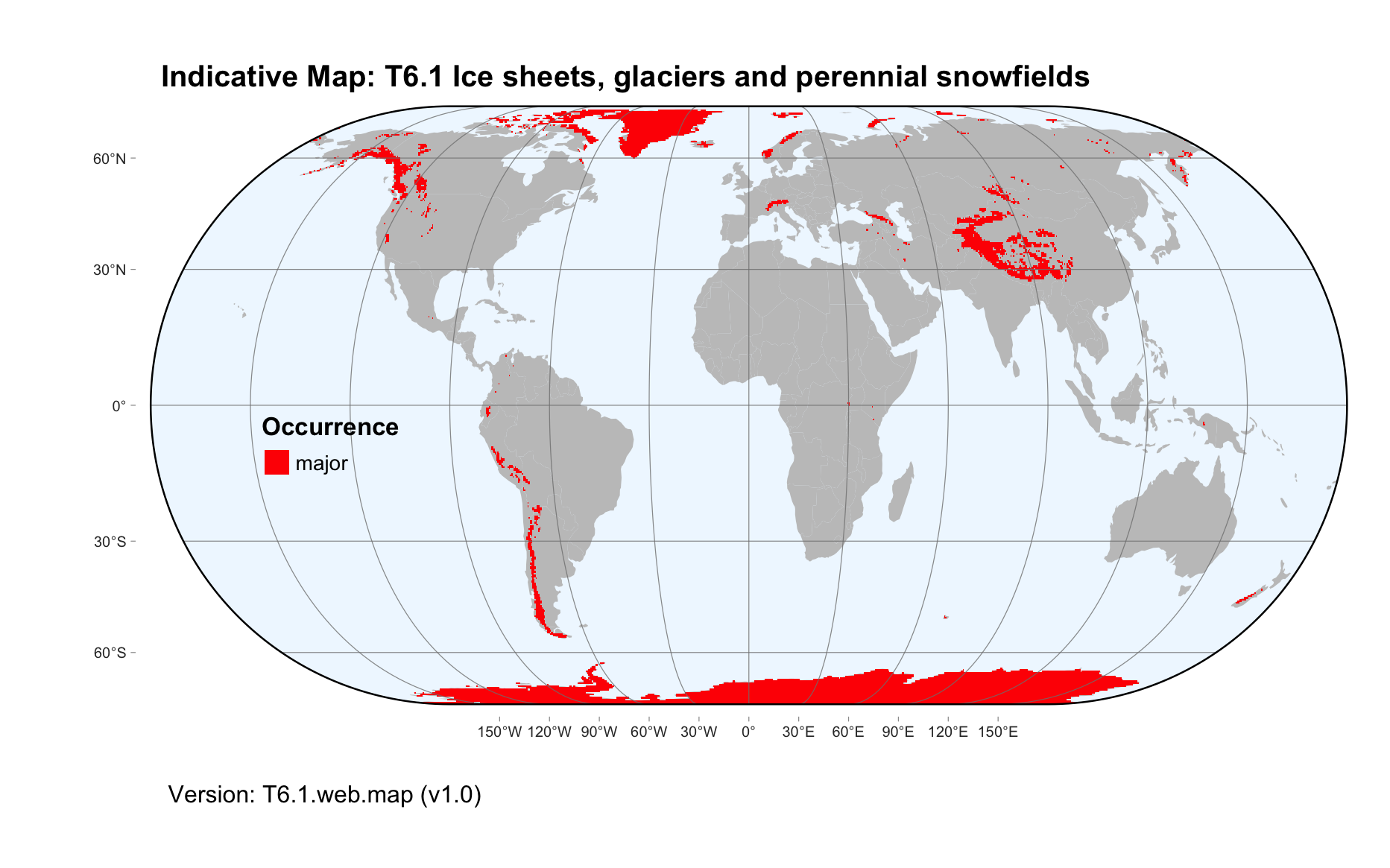Global ecosystem typology
Alternative site for the Global ecosystem typology with additional information for ecosystem profiles and indicative maps.
This site is maintained by jrfep
T6.1 Ice sheets, glaciers and perennial snowfields
Biome: T6. Polar/alpine (cryogenic) biome
Contributors:
(texts)
Found in polar regions and on high mountains, ice sheets, glaciers and perennial snowfields make up around 10% of the earth’s surface. They have very low productivity and diversity in extreme cold conditions. Nutrients are in short supply, and generally come from glacial debris, seawater or guano. At the base of simple foodwebs, micro-organisms such as bacteria, viruses and algae are the dominant life forms, although itinerant vertebrates make important contributions to nutrient and carbon subsidies. Micro-organisms are often dispersed by wind, and accumulate organic matter at the surface, fuelling microbial activity both at the surface, and below the ice. Productivity is restricted to summer months, when migratory birds and mammals visit.
Key Features
Permanent, dynamic ice cover where extreme cold limits productivity and diversity, biota dominated by microorganisms, migratory/overwintering birds may occur.
Overview of distribution
Polar regions and high mountains in the western Americas, central Asia, Europe, and New Zealand.
Profile versions
- v1.0 (2020-01-20): DA Keith; A Terauds
- v2.0 (2020-05-31): DA Keith; A Terauds; AMB Anesio
- v2.01 ():
- v2.1 (2022-04-06): DA Keith; A Terauds; AMB Anesio Full profile available at official site
Main references
Selected references for this functional group:
Anesio AM, Laybourn-Parry J (2012) Glaciers and ice sheets as a biome. Trends in Ecology and Evolution 27, 219-225. DOI:10.1016/j.tree.2011.09.012
Anesio AM, Lutz S, Chrismas NAM. Benning LG (2017) The microbiome of glaciers and ice sheets npj Biofilms Microbiomes 3, 10
Diagrammatic assembly model

Maps
Maps are indicative of global distribution patterns are not intended to represent fine-scale patterns. The maps show areas of the world containing major (coloured red) or minor occurrences (coloured yellow) of each ecosystem functional group. See general notes on maps.
There are 2 alternative versions of the indicative map for this functional group, please compare description and sources below.
T6.1.IM.alt_v2.0
Datasets
- EarthEnv-LandCover-v1.0
- GLIMS-2007
- Antartica-LC-2000
- GLIMS-2007
Map references
Tuanmu, M.-N. and W. Jetz (2014) A global 1-km consensus land-cover product for biodiversity and ecosystem modeling Global Ecology and Biogeography 23(9):1031–1045 DOI:10.1111/geb.12182
Raup, B.H.; A. Racoviteanu; S.J.S. Khalsa; C. Helm; R. Armstrong; Y. Arnaud (2007) The GLIMS Geospatial Glacier Database: a New Tool for Studying Glacier Change Global and Planetary Change 56:101–110 DOI:10.1016/j.gloplacha.2006.07.018
Hui, F., J. Kang, Y. Liu, X. Cheng, P. Gong, F. Wang, Z. Li, Y. Ye, and Z. Guo. 2017. AntarcticaLC2000: The new Antarctic land cover database for the year 2000. SCIENCE CHINA Earth Sciences 60: 686-696. doi: 10.1007/s11430-016-0029-2.
T6.1.web.map_v1.0

Datasets
- GLIMS-2007
- EarthEnv-LandCover-v1.0
- Antartica-LC-2000
- GLIMS-2007
Map references
Raup, B.H.; A. Racoviteanu; S.J.S. Khalsa; C. Helm; R. Armstrong; Y. Arnaud (2007) The GLIMS Geospatial Glacier Database: a New Tool for Studying Glacier Change Global and Planetary Change 56:101–110 DOI:10.1016/j.gloplacha.2006.07.018
Tuanmu, M.-N. and W. Jetz (2014) A global 1-km consensus land-cover product for biodiversity and ecosystem modeling Global Ecology and Biogeography 23(9):1031–1045 DOI:10.1111/geb.12182
Hui, F., J. Kang, Y. Liu, X. Cheng, P. Gong, F. Wang, Z. Li, Y. Ye, and Z. Guo. 2017. AntarcticaLC2000: The new Antarctic land cover database for the year 2000. SCIENCE CHINA Earth Sciences 60: 686-696. doi: 10.1007/s11430-016-0029-2.
Check: the Glossary / Profile structure / the public document